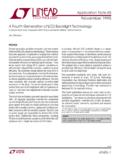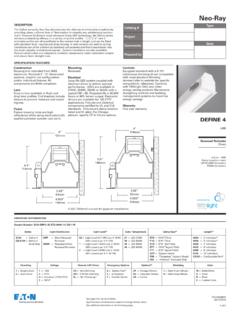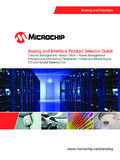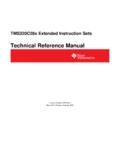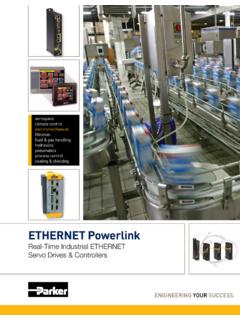Transcription of Data Logger Fundamentals for Environmental Monitoring ...
1 Data Logger Fundamentals for Environmental Monitoring applications The following is a basic overview of data Logger features and specifications with relevance to Environmental Monitoring applications . Although data loggers are used in many industries from space exploration, to oil refining, to drag racing, we will be focusing on their application for Environmental Monitoring . What is a datalogger? A data Logger is an electronic instrument that records Environmental parameters such as temperature, relative humidity, wind speed and direction, light intensity, water level and water quality over time. Typically, data loggers are compact, battery-powered devices that are equipped with microprocessor input channels and data storage. Most data loggers utilize turnkey software on a personal computer to initiate the Logger and view the collected data. Who uses Data Loggers? The use of data loggers for Environmental Monitoring became common during the 1980's; coinciding with the explosion in personal computers (PC's).
2 This is no coincidence since a data Logger consists of many of the same, or similar, components used to manufacture a PC. In fact, a data Logger is basically a stripped down 386 vintage PC with input channels, instead of a keyboard and floppy drive, which operates on battery power. As the price of PC components dropped, data loggers became more affordable for a wider array of applications . Before then, chart recorders were commonly used as well as manual measurements. Both of these methods were labor intensive and time consuming so the advent of stand alone data loggers was welcomed. In Canada some of the early adopters included Environment Canada (Atmospheric Environmental Service and Water Survey of Canada) and the Provincial Hydro companies (Quebec Hydro, Ontario Hydro, Sask Power, BC Hydro, etc.) as well as Provincial Ministries such as BC Ministry of Forests (Fire Weather Index Monitoring ) and BC Ministry of Transportation (Snow Avalanche Monitoring ). These organizations had a large stake in obtaining meteorological and hydrometric data to protect people, land and assets, as well as establish base line data sets from which long and short term plans could be developed.
3 As the decade progressed a greater variety of data loggers were developed at lower costs, making data loggers affordable for not only large long term network application but also for smaller temporary projects. With the rapid advent of microprocessor and memory technology, data loggers are now available for virtually any Monitoring project from as little as $ Hence, today's users of data loggers span from a single installation for measure temperature to meteorological networks of hundreds of stations Monitoring temperature, relative humidity, barometric pressure, solar radiation, precipitation and wind speed & direction. Why are data loggers used? A data Logger is used to collect readings, or output, from sensors. These sensors could be measuring industrial parameters such as pressure, flow and temperature or Environmental parameters such as water level, wind speed or solar radiation. Today there are sensors available which can measure virtually any physical parameter.
4 Senors have been developed to measure gas pressure within human cells to cloud height and density. Most sensors are based on physical and chemical theories that have been discovered long ago, such as the theory of partial pressure of gasses, the Doppler theory and metal resistance changes with temperature. Most Environmental sensors were developed from sensors designed for industrial applications such as process control (refining, milling, distilling, etc.). Therefore many Environmental sensors are designed with the same characteristics as industrial sensors such as 4-20 mA output & 12 VDC power supply. How do data loggers work? The 8 main components of a data Logger are: 1 - Input Channels The output from a sensor is inputted or connected to a data Logger channel. A channel consists of circuitry designed to 'channel' a sensor signal (typically a voltage or current) from the sensor to the data Logger processor. A single data Logger can have a variety of channel types and from one to many channels (multi-channel data Logger ) - one channel is required for every sensor signal output.
5 For example, four sensors can be connected to a four channel data Logger and eight sensors to a eight channel Logger . Typically, a multi-channel Logger will have from four to 16 channels. Three types of channels are typically found on a mult i-channel data Logger , they are: Analog Channel Analog channels are the most common types of input channel found on multi-channel data loggers since most sensors have an analog output. Webster defines analog as: "of relating to, or being a mechanism in which data is represented by continuously variable physical quantities" and "being a timepiece having hour and minute hands" A characteristic of analog signals is they are continuous ( , do not change in fixed increments) over their range and most analog sensors are linear. An analog sensor will output an electrical signal, typically a voltage (mV), which is proportional to an Environmental parameter such as air temperature. Graphically, the relationship between voltage and air temperature, will be a smooth curve or straight line (linear).
6 For example a temperature sensor may have a range from 0 to 100 degrees Celsius and output a signal from 0 to 5 Volts: Temperature Output Voltage 0 degC 0 volts 100 degC 5 volts Therefore if the temperature is 0 degC the sensor will output 0 volts, and if the temperature is 100 degC the sensor will output 5 volts. If the above sensor is linear (directly proportional) it will output volts at 50 degC, and at degC it will output volts. Typical analog sensors include: Meteorology Hydrology / Water Quality Temperature Pressure / Level Relative Humidity Temperature Solar Radiation pH Barometric Pressure Conductivity Wind Direction Dissolved Oxygen Leaf Wetness Turbidity Digital Channel Digital channels are the second most common type of input channel found on multi-channel data loggers.
7 Webster defines digital as: "of relating to, or using calculation by numerical methods or by discrete units" and "of or relating to data in the form of numerical digits" The main characteristic of digital signals is they increase and decrease in discrete or fixed intervals. Graphically the 'curve' of a digital signal would increase or decrease in a 'staircase' like pattern. The signal output has an on/off characteristic and is not continuous. For example, a wind speed sensor may contain a contact switch that closes each time the wind sensor does a revolution. Therefore, if the sensor does only 3/4 of a revolution the switch will not close, only when it does a full revolution it closes. After a second full revolution, it closes again. Graphically, the relationship between contact closures and wind speed would be in steps and could or could not be linear. Knowing the sensor characteristics, or calibration factor, and if the closures are measured over a fixed time interval, the wind speed can be calculated.
8 For instance 100 revolutions per minute may equal a wind speed of 5 km/hr and 200 revolutions per minute may equal a wind speed of 10 km/hr. The datalogger accumulates, or totalizes, the discrete closures over a fixed time interval. Revolutions per Minute Wind Speed 100 5 km/hr 200 10 km/hr Typical digital sensors include: Meteorology Hydrology Wind Speed Sensor Paddle Wheel Flow Sensor Tipping Bucket Rain Gauge Tipping Bucket Flow Sensor SDI-12 (Serial Digital Interface) Developed in the late 1980's to take advantage of reasonably priced microprocessors, SDI-12 is an abbreviation for Serial Data Interface at 1200 baud. It is a standard to interface data loggers with micro-processor based sensors designed specifically for Environmental Data Acquisition (EDA). SDI-12 is a standard communications protocol that provides a means to transfer measurements taken by an intelligent sensor to a data Logger .
9 A micro-processor in the sensor may calibrate the sensor, control sensor measurements, convert raw sensor readings into engineering units, and uses the SDI-12 protocol to transfer reading to the data Logger . For example, a SDI-12 pressure sensor may take a series of pressure measurements, average them, and then output pressure in psi, inches of mercury, bars, millibars, or torrs to the data Logger . SDI-12 is ideal for use in applications with the following requirements: - Battery powered operation with minimal current drain. - Use of one data recorder with multiple sensors on a single cable. - Use with microprocessor-based sensors that perform complex calibration algorithms or make internal computations such as temperature compensation. Virtually any analog or digital sensor can, and has, been modified into a SDI-12 sensor, however the cost is prohibitive in many cases. 2 - A/D converter (Analog to Digital Converter) All sensor signals, analog, digital and SDI-12, must be in binary format in order for the data Logger to record them.
10 Binary data format is not specific to data loggers but is the fundamental data format used by virtually all computers from digital cameras to NASA mainframe computer. Binary Data Format Binary describes a numbering scheme in which there are only two possible values for each digit: 0 and 1. The term also refers to any digital encoding/decoding system in which there are exactly two possible states. In digital data memory, storage, processing, and communications, the 0 and 1 values are sometimes called "low" and "high", respectively. A bit represents a positive "high", or negative "low" electric charge (which is stored in a silicon chip). These are the only two digits the computer can understand. Because of this, computers work on a binary number system, instead of the decimal system we are familiar with. The word bit stands for binary digit. The computer interprets the negative and positive electric charges as binary digits (bits), and groups eight bits together into a byte.

